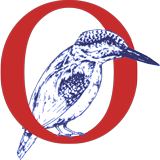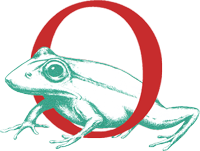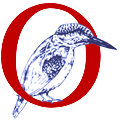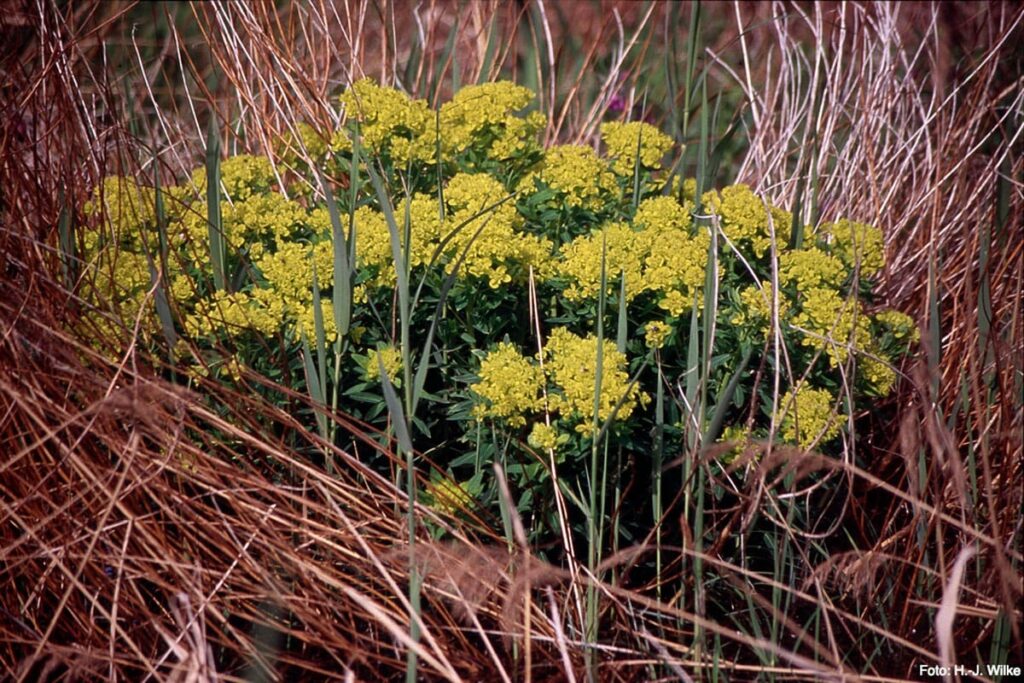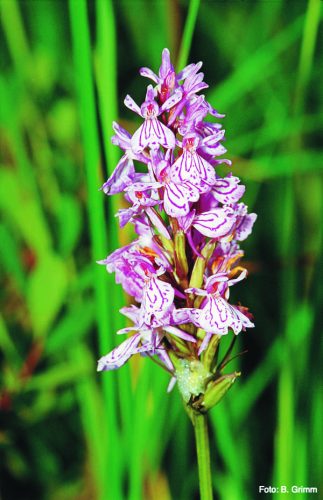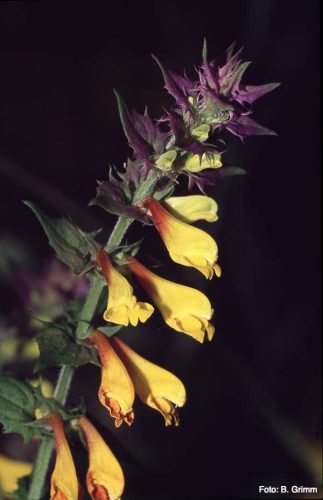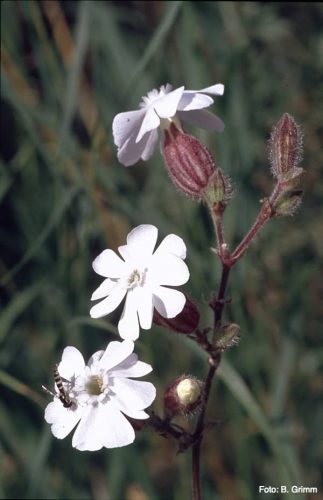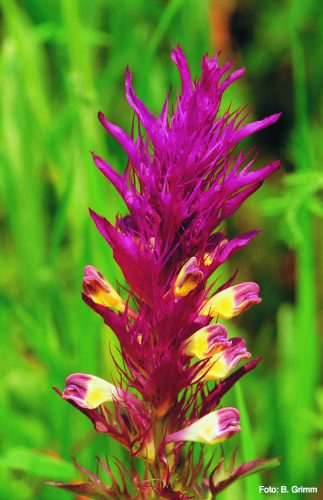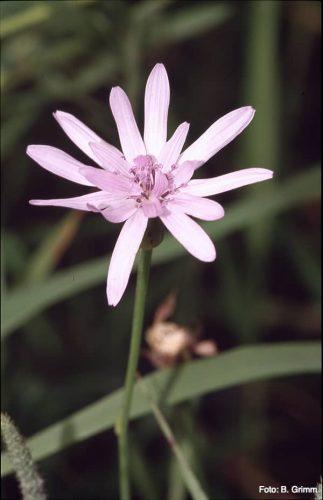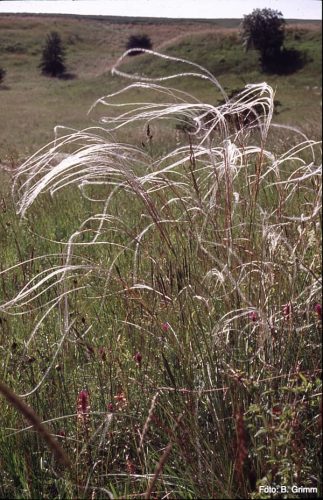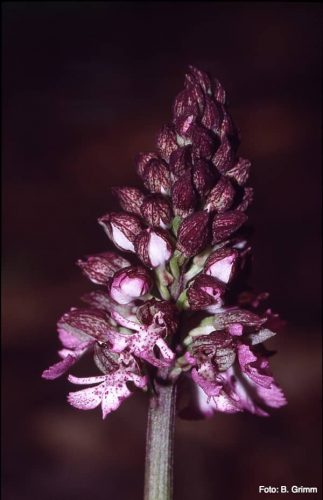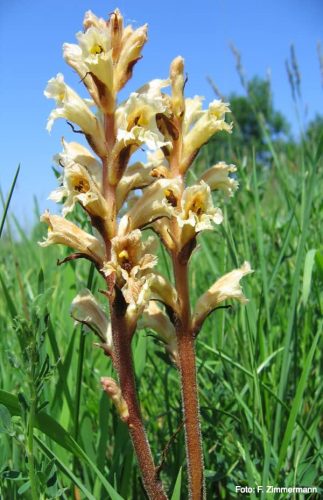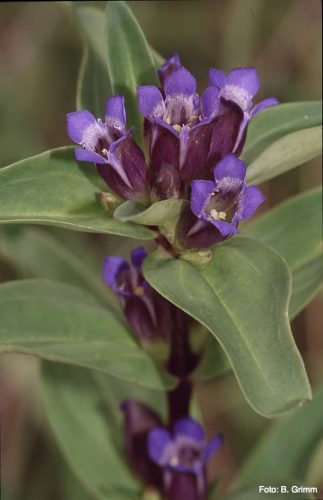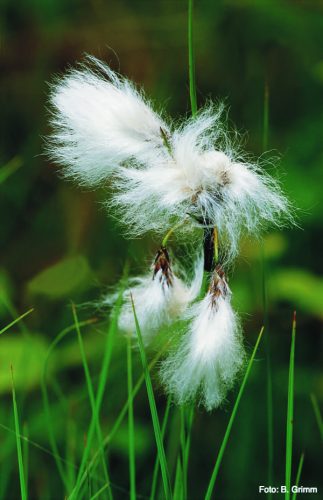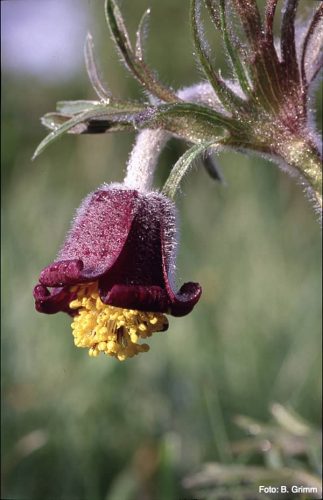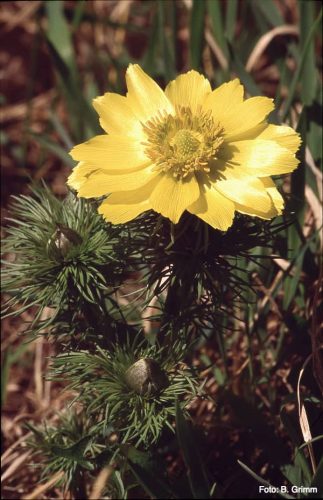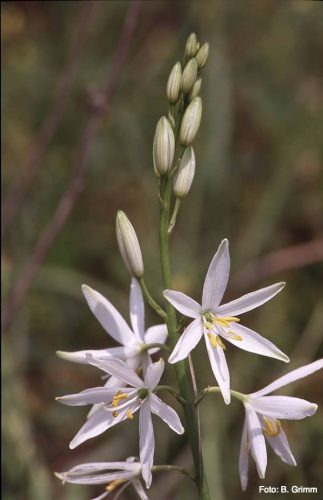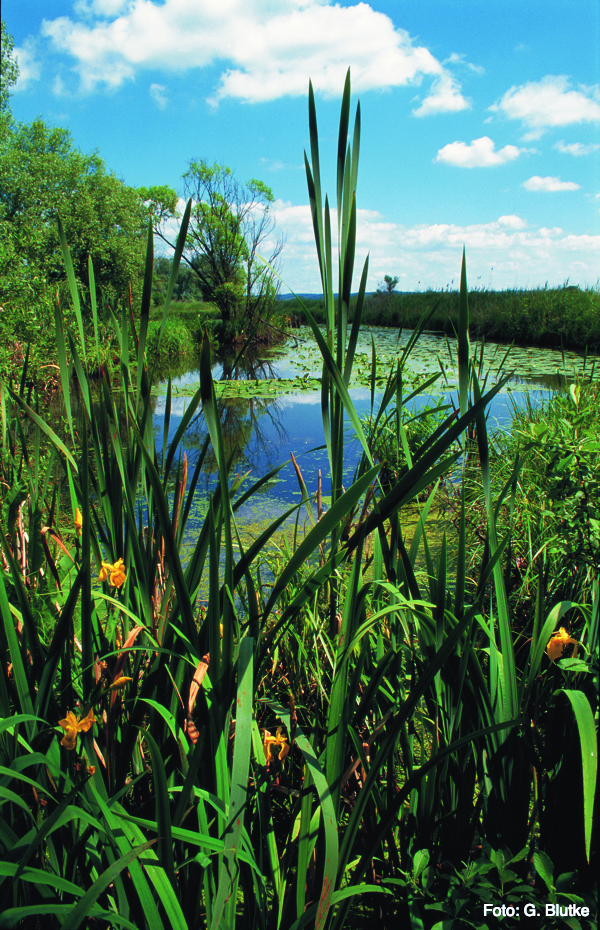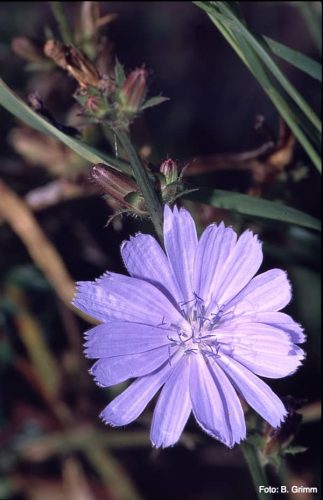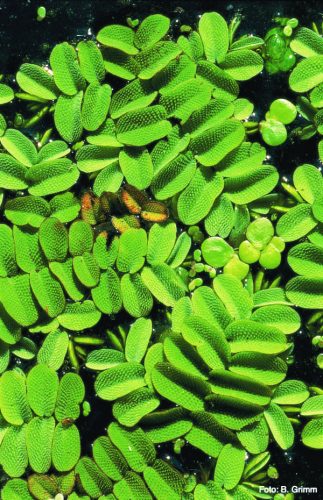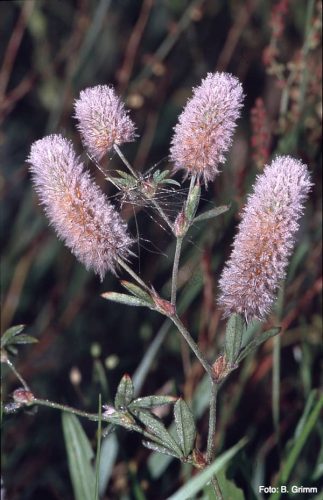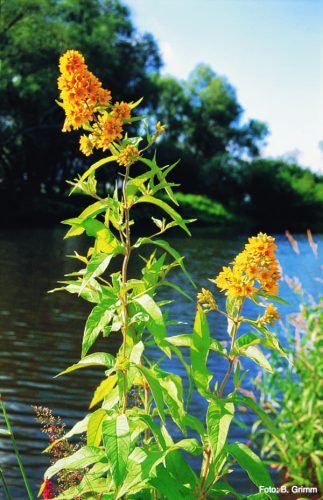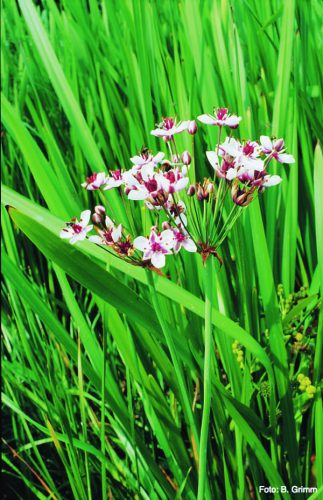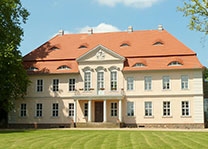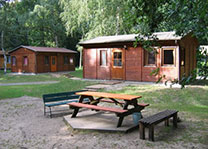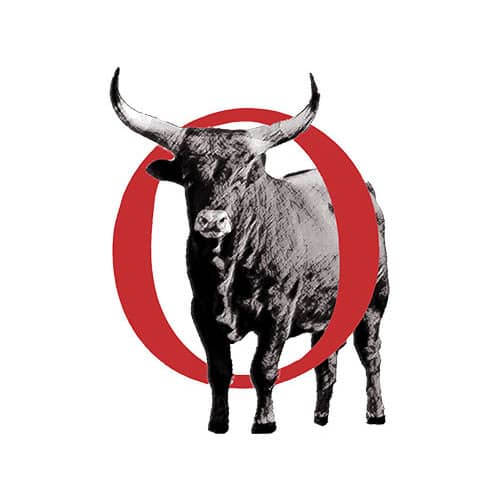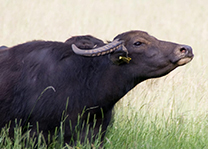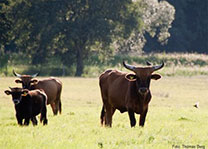Species richness and hazard potential
- Marsh milkweed
In the national park area, extensive examinations of the fauna and flora were carried out until 1998. A total of 1,726 plant species were identified, which can be grouped into 90 types of vegetation and 44 plant communities, 12 of which are aquatic plant communities. Of the 1,726 identified plant species, 303, i.e. 17.6 %, on the Red List of Endangered Ferns and Flowering Plants of the State of Brandenburg, 38 of which belong to Category 1, i.e. to the species directly threatened with extinction. Among them are the mountain asters (Aster amellus), the bristly and broad-leaved bellflower (Campanula cervicaria and Campanula latifolia), the Pentecost carnation (Dianthus gratianopolitanus), the wire-haired elephant (Inula hirta), the mountain herb (Libanotis montana), the purple orchid (Orchis purpurea) or the species that were recently recorded in Brandenburg for the first time, such as yellow-sheathed feather grass (Stipa pulcherrima) and the downy oak (Quercus pubescens), which have their only Brandenburg location in the lower Oder valley. 149 species are listed as threatened on the Red List of the Federal Republic of Germany. The high presence of these threatened plant species shows the importance of the project area for species and biotope protection. Almost every sixth Red List species in the federal territory and 44.5% of the Red List species in the State of Brandenburg occur in the lower Oder valley, with the species threatened being evenly distributed between the wet and dry locations.
The Federal Republic of Germany bears a special responsibility for the preservation of 14 plant species growing in the project area, as these occur exclusively or almost exclusively here, with a decreasing trend. For example, four out of five known sites of sand feather grass in Germany and Brandenburg are here (Stipa borysthenica). The conservation of this feather grass species is only possible here and in adjacent areas. It is therefore one of the most important species in the area in terms of nature conservation.
As a result of a summarizing, nature conservation assessment, it can be stated that the rare plant communities can be found predominantly in the arid areas of the hill country and in the Oder foothills, while more frequent plant communities can be found in the polders.
- Spotted orchid
- Book quail wheat
- White catchfly
- Field quail wheat
- Violet black salmon
- Feather grass
Plant geography
The lower Oder valley is also of outstanding importance for plant-geographical reasons. With the flat-leaved man litter (Eryngium planum), the glossy milkweed (Euphorbia lucida) and the Tatar catchfly (Silene tatarica) flow valley plants from the continental areas of Europe and Asia reach the Oder valley and are found here just like, for example, the adder’s head hawkweed (Hieracium echioides) and the Siberian bellflower (Campanula sibirica) the absolute western limit of their European distribution in the dry grassland. With the occurrence of these species, the above-described continental climatic influences are documented floristically.
The sand carnation, which is only found in Northern Europe (Dianthus arenarius) reaches its southwest border in the lower Oder valley. The location around Gartz, which is rich in individuals, is of particular importance throughout Germany.
In contrast, a number of species of the boreal-circumpolar species are present in acidic forests and in the nutrient-rich silting bogs. This subheading includes many wintergreen plants (Pyroloceae), some sedge plants (Cyperaceae), for example the even relatively common beak sedge and the bladder sedge (Carex rostrata, Carex vesicaria) or the swamp heart leaf, which blooms so beautifully in summer (Parnassia palustris), which, contrary to its name, can be found mainly on dry grasslands in the lower Oder valley.
There are no longer any real “Atlanticists” on the lower Oder, because the temperature in the annual mean and the amount of precipitation already differ greatly from the sea climate. Only a few sub-Atlantic-Nordic species can also be found in the lower Oder valley. These include the silver grass (Corynephorus canescens), the broom (Sarothamnus scoparius), the hair gorse (Genista pilosa), the forest sedge and the sand sedge (Carex sylvatica and Carex arenaria), the common heather (Calluna vulgaris) and the early Haferschmiele (Aira praecox).
There are only a few species of sub-Mediterranean plants, but they have a clear center of abundance in the lower Oder valley, many hundreds of kilometers from their closed range. As such, the purple orchid (Orchis purpurea) and the downy oak recently found on the German side of the Oder (Quercus pubescens) to call.
On the other hand, there is a large group of plants that are common both in the Eastern European plant communities and in the dry forests and dry grasslands of southern Europe. In addition to the ones already mentioned, these include such rare species as the showy and famous spring Adonis (Adonis vernalis), the cross gentian (Gentiana cruciata), the purple salsify (Scorzonera purpurea), the great anemone (Anemone sylvestris), some summer root species (Orobanche purpurea, Orobanche lutea and Orobanche arenaria), the shaggy flag vetch (Oxytropis pilosa), the deer root, which blooms so magnificently in autumn (Peucedanum cervaria) or the service tree (Sorbus torminalis), which as a tree can reach an enormous age.
Two montane deciduous forest species are to conclude the plant-geographical part: The Christophskraut (Actaea spicata), which flowers at the end of May, and the Zwiebel-Zahnwurz (Dentaria bulbifera) with its small brownish-purple brood bulbs in the leaf axils. They are only found in very naturally established maple and beech forests.
- Purple orchid
- Yellow arum
- Cross gentian
- Narrow-leaved cotton grass
- Spring Pasque Flower
- Spring Adonis
- Knotless grass lily
Plant sociology
Even more interesting than the individual plant species are the plant communities composed according to the biotic and abiotic factors. Despite numerous individual works on the German and Polish side, no complete monographic study has yet been published. 115 associations have been recorded so far.
In the natural backwater remains of the Oder floodplain, the pools, the canals and the ditches, aquatic plant communities can be found that have significantly improved in quality in recent years as a result of decreasing anthropogenic influences. So emerged with the thread pondweed (Potamogeton filiformis) revived a species that had long disappeared in the area. Some water root societies with the rootless duckweed (Wolffia arrhiza) or with the swimming fern (Salvinia natans). The often tightly closed stocks of water lilies offer the observer an aesthetically pleasing sight, but are relatively poor in species. The large floating leaves of the water lily darken the submerged hydroflora and thus prevent its development, especially since the depth of visibility of the water in eutrophic bogs is already low.
Reeds are rare in the Oder Valley because the corresponding shallow water zones with their silting areas are largely lacking. Only the reed beds of swan flowers are more common, especially at the river edges in the direct river area of the Oder and fall in summer due to the bright pink inflorescences of the swan flower, which often appear in large numbers (Butomus umbellatus) especially on. Even the plumes of water (Glyceria maxima) can dominate on mud banks, sedimented ponds or other excavations with strongly fluctuating water levels.
As a rule, the waters in the polders are bounded by nitrophilic riparian perennials and fringing communities, which are defining structural elements in the polder landscape. The bindweed angelica society with its huge umbel inflorescences of the real angelica (Angelica archangelica) as a specialist society requires high water levels all year round with low flow speeds and a good supply of nutrients. Above the mean water line it is replaced by the nettle silk winch society, in which the tree silk (Cuscuta lupuliformis) and the hop silk (Cuscuta europaea), both rootless and leafless parasites, wind up on the shoot axes of the other tall perennials and often depress them in autumn. On the other hand, the bank fringes can also be covered with willow bushes or individually or in groups standing tree-shaped white willows, which represent a special type of vegetation in the area of the softwood floodplains. In purely formal terms, these stocks can be classified as remnants of softwood alluvial forest. However, this would be in stark contrast to the real alluvial forests, because with these stands there is hardly a forest climate and therefore ecologically completely different conditions are given. It would be better to define a separate biotope type for these stocks and to designate it as a Central European “gallery forest”, analogous to similarly structured stocks, for example in savannas or steppe areas.
The actual polder areas are largely free of forests. More extensive sedge meadows can be found in the northern part of the Fiddichower Polder. The characteristic society of the polders and the fore-dike areas are reed grass beds, which are made up of reed grass (Phalaris arundinacea) can be mastered. Depending on their location in relation to the current or the duration of the flooding, they can be designed very differently. They contain some of the river valley plants characteristic of Brandenburg, such as the willow leaf yarrow (Achillea salicifolia), the cat’s tail (Leonurus marrubiastrum) or the meadow elephant (Inula britannica) optimal growing conditions. Foxtail meadows have formed on higher-lying locations, but as a result of their intensive use, they still give a less natural impression and are in some cases even ruderalized due to overuse. If these locations are used extensively, and especially if the mowing is single in late summer, the continental red cone and pipe grass meadow (Violo — Cnidietum), which is generally rare in Europe, is developed on such locations. Targeted biotope management in recent years has made it possible to secure their remaining stocks. They are even expanding at the moment.
At approximately the same moisture level, after these types of meadow have been abandoned, a meadow-like high herbaceous meadow develops, which is mainly made up of glossy milkweed (Euphorbia lucida) is mastered. From the large, yellow pseudo-inflorescences of the milkweed in early summer to the blue inflorescences of the asters in autumn, this plant community is one of the highlights of the vegetation of the lower Oder valley.
- Plant community in the Lower Oder Valley National Park
- Chicory
- Floating fern
- Hasenklee
- Common loosestrife
- Swan flower
Further reading
Vössing, A. (1998): The International Park Unteres Odertal — a work and hiking book , ISBN: 3877769349
